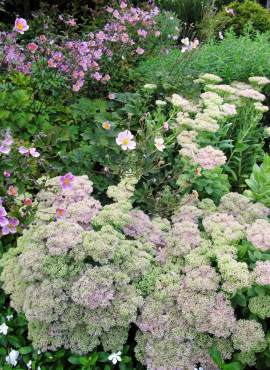
As you stroll through the garden in the heat of the day, plants don’t seem to have that oomph they had in the spring. Some say it’s just too hot to garden and are waiting for fall planting time to even think about getting out the shovel. So it goes, the dog days of summer in the garden.
While the garden is less demanding this time of year, there are a few tasks that will help keep the garden lively.
Deadhead Flowers
Most perennials will have a second flush of fall bloom when faded blossoms are removed. Lavender, Rudbeckia, Dianthus and Rugosa roses will all respond with second bloom after a trimming.
Be unmerciful to fading annuals and remove any dead blossoms. If they are fizzling in the heat and are no longer heavily blooming, toss them into the compost bin.
Some can be deadheaded, but by the time they come back for another round, you might be better off adding fresh color with winter pansies, mums and ornamental cabbages.
Fill Empty Spaces
This is a great time to look at mixed borders and planting beds that are all done with their early blooms, and add late-blooming perennial color. This ensures a planting mix that will extend a season of color.
Late great bloomers include “Autumn Joy” Sedum, “Goldsturm,” Rudbeckia, Crocosmia and Japanese Anemone. Ornamental grasses will also add a pop of interest well into fall.
Enjoy the Herbal Harvest
As herbs rapidly grow in the late summer heat, keep them pruned to encourage bushiness and continued leaf production.
Bundle harvested herbs to dry and store for seasonings and tea blends. Make herbal ice cubes with fresh mint leaves for cool summer drinks. Freeze herbs such as oregano, marjoram and basil for seasoning sauces and soup in the winter months.
To make herbal ice cubes, add whole leaf or snip into fine pieces and put into the sections of ice cube trays. Cover the herbs with water and freeze. Place the cubes in zip seal bags and store in the freezer.
Plant Some Veggies
August is a good time to sow fall and winter vegetables. Easy-to-grow crops you can start now include beets, cabbage, carrots, lettuce, green onions, spinach and turnips. Try for another crop of peas and beans; if the weather holds well into the fall, you can harvest peas for Thanksgiving dinner.
Make sure you hit the seed racks now before the stores remove them to make room for all the holiday merchandise coming in.
Feed Hungry Hanging Baskets
They have bloomed their hearts out all season but if the blooms are not as great as they were earlier in the season, then your basket is hungry. Make sure to use a good water-soluble fertilizer once a week if you want to keep them going well into late fall.
Be on Pest Patrol
Spider mites and aphid activity increases in the summer heat. One of the best defenses is to be on patrol and treat the problem before it becomes full-blown.
Look at the underside of leaves and along stems for aphids, watch for telltale spider mite webbing in evergreens and dense shrubs.
Use an organic or natural pest control and follow the label directions. The low toxicity of these products means you need may need to do a few rounds of spray, typically every ten days. Be diligent, as these are not one-time, hard-hit chemicals, but are much safer for the beneficial bugs that are out in full force this time of year too.
And most of all, enjoy the fading days of summer and bountiful harvests.

























